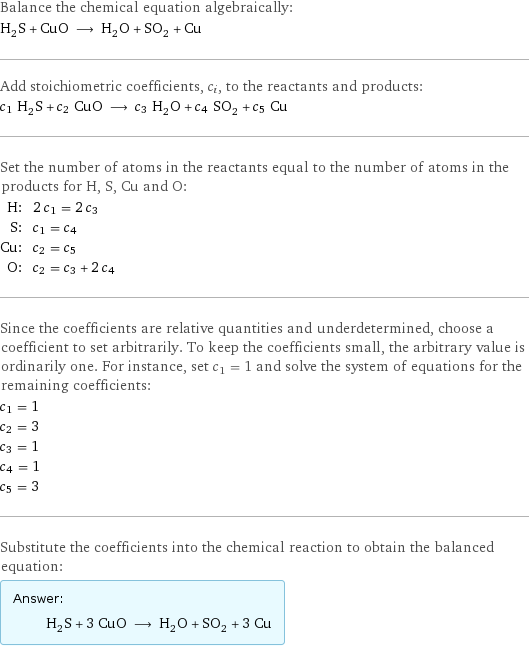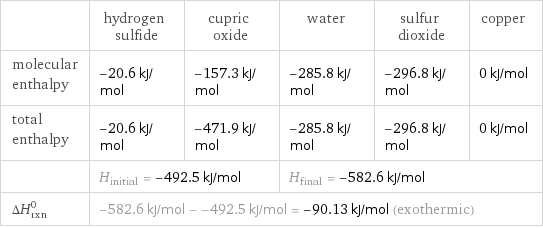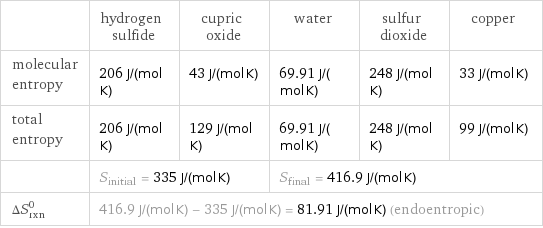Input interpretation

H_2S hydrogen sulfide + CuO cupric oxide ⟶ H_2O water + SO_2 sulfur dioxide + Cu copper
Balanced equation

Balance the chemical equation algebraically: H_2S + CuO ⟶ H_2O + SO_2 + Cu Add stoichiometric coefficients, c_i, to the reactants and products: c_1 H_2S + c_2 CuO ⟶ c_3 H_2O + c_4 SO_2 + c_5 Cu Set the number of atoms in the reactants equal to the number of atoms in the products for H, S, Cu and O: H: | 2 c_1 = 2 c_3 S: | c_1 = c_4 Cu: | c_2 = c_5 O: | c_2 = c_3 + 2 c_4 Since the coefficients are relative quantities and underdetermined, choose a coefficient to set arbitrarily. To keep the coefficients small, the arbitrary value is ordinarily one. For instance, set c_1 = 1 and solve the system of equations for the remaining coefficients: c_1 = 1 c_2 = 3 c_3 = 1 c_4 = 1 c_5 = 3 Substitute the coefficients into the chemical reaction to obtain the balanced equation: Answer: | | H_2S + 3 CuO ⟶ H_2O + SO_2 + 3 Cu
Structures

+ ⟶ + +
Names

hydrogen sulfide + cupric oxide ⟶ water + sulfur dioxide + copper
Reaction thermodynamics
Enthalpy

| hydrogen sulfide | cupric oxide | water | sulfur dioxide | copper molecular enthalpy | -20.6 kJ/mol | -157.3 kJ/mol | -285.8 kJ/mol | -296.8 kJ/mol | 0 kJ/mol total enthalpy | -20.6 kJ/mol | -471.9 kJ/mol | -285.8 kJ/mol | -296.8 kJ/mol | 0 kJ/mol | H_initial = -492.5 kJ/mol | | H_final = -582.6 kJ/mol | | ΔH_rxn^0 | -582.6 kJ/mol - -492.5 kJ/mol = -90.13 kJ/mol (exothermic) | | | |
Entropy

| hydrogen sulfide | cupric oxide | water | sulfur dioxide | copper molecular entropy | 206 J/(mol K) | 43 J/(mol K) | 69.91 J/(mol K) | 248 J/(mol K) | 33 J/(mol K) total entropy | 206 J/(mol K) | 129 J/(mol K) | 69.91 J/(mol K) | 248 J/(mol K) | 99 J/(mol K) | S_initial = 335 J/(mol K) | | S_final = 416.9 J/(mol K) | | ΔS_rxn^0 | 416.9 J/(mol K) - 335 J/(mol K) = 81.91 J/(mol K) (endoentropic) | | | |
Equilibrium constant
![Construct the equilibrium constant, K, expression for: H_2S + CuO ⟶ H_2O + SO_2 + Cu Plan: • Balance the chemical equation. • Determine the stoichiometric numbers. • Assemble the activity expression for each chemical species. • Use the activity expressions to build the equilibrium constant expression. Write the balanced chemical equation: H_2S + 3 CuO ⟶ H_2O + SO_2 + 3 Cu Assign stoichiometric numbers, ν_i, using the stoichiometric coefficients, c_i, from the balanced chemical equation in the following manner: ν_i = -c_i for reactants and ν_i = c_i for products: chemical species | c_i | ν_i H_2S | 1 | -1 CuO | 3 | -3 H_2O | 1 | 1 SO_2 | 1 | 1 Cu | 3 | 3 Assemble the activity expressions accounting for the state of matter and ν_i: chemical species | c_i | ν_i | activity expression H_2S | 1 | -1 | ([H2S])^(-1) CuO | 3 | -3 | ([CuO])^(-3) H_2O | 1 | 1 | [H2O] SO_2 | 1 | 1 | [SO2] Cu | 3 | 3 | ([Cu])^3 The equilibrium constant symbol in the concentration basis is: K_c Mulitply the activity expressions to arrive at the K_c expression: Answer: | | K_c = ([H2S])^(-1) ([CuO])^(-3) [H2O] [SO2] ([Cu])^3 = ([H2O] [SO2] ([Cu])^3)/([H2S] ([CuO])^3)](../image_source/7718a9ee86a7e94a59f9b44742a713b2.png)
Construct the equilibrium constant, K, expression for: H_2S + CuO ⟶ H_2O + SO_2 + Cu Plan: • Balance the chemical equation. • Determine the stoichiometric numbers. • Assemble the activity expression for each chemical species. • Use the activity expressions to build the equilibrium constant expression. Write the balanced chemical equation: H_2S + 3 CuO ⟶ H_2O + SO_2 + 3 Cu Assign stoichiometric numbers, ν_i, using the stoichiometric coefficients, c_i, from the balanced chemical equation in the following manner: ν_i = -c_i for reactants and ν_i = c_i for products: chemical species | c_i | ν_i H_2S | 1 | -1 CuO | 3 | -3 H_2O | 1 | 1 SO_2 | 1 | 1 Cu | 3 | 3 Assemble the activity expressions accounting for the state of matter and ν_i: chemical species | c_i | ν_i | activity expression H_2S | 1 | -1 | ([H2S])^(-1) CuO | 3 | -3 | ([CuO])^(-3) H_2O | 1 | 1 | [H2O] SO_2 | 1 | 1 | [SO2] Cu | 3 | 3 | ([Cu])^3 The equilibrium constant symbol in the concentration basis is: K_c Mulitply the activity expressions to arrive at the K_c expression: Answer: | | K_c = ([H2S])^(-1) ([CuO])^(-3) [H2O] [SO2] ([Cu])^3 = ([H2O] [SO2] ([Cu])^3)/([H2S] ([CuO])^3)
Rate of reaction
![Construct the rate of reaction expression for: H_2S + CuO ⟶ H_2O + SO_2 + Cu Plan: • Balance the chemical equation. • Determine the stoichiometric numbers. • Assemble the rate term for each chemical species. • Write the rate of reaction expression. Write the balanced chemical equation: H_2S + 3 CuO ⟶ H_2O + SO_2 + 3 Cu Assign stoichiometric numbers, ν_i, using the stoichiometric coefficients, c_i, from the balanced chemical equation in the following manner: ν_i = -c_i for reactants and ν_i = c_i for products: chemical species | c_i | ν_i H_2S | 1 | -1 CuO | 3 | -3 H_2O | 1 | 1 SO_2 | 1 | 1 Cu | 3 | 3 The rate term for each chemical species, B_i, is 1/ν_i(Δ[B_i])/(Δt) where [B_i] is the amount concentration and t is time: chemical species | c_i | ν_i | rate term H_2S | 1 | -1 | -(Δ[H2S])/(Δt) CuO | 3 | -3 | -1/3 (Δ[CuO])/(Δt) H_2O | 1 | 1 | (Δ[H2O])/(Δt) SO_2 | 1 | 1 | (Δ[SO2])/(Δt) Cu | 3 | 3 | 1/3 (Δ[Cu])/(Δt) (for infinitesimal rate of change, replace Δ with d) Set the rate terms equal to each other to arrive at the rate expression: Answer: | | rate = -(Δ[H2S])/(Δt) = -1/3 (Δ[CuO])/(Δt) = (Δ[H2O])/(Δt) = (Δ[SO2])/(Δt) = 1/3 (Δ[Cu])/(Δt) (assuming constant volume and no accumulation of intermediates or side products)](../image_source/37b2a9c3817845f30b2b8fd752610784.png)
Construct the rate of reaction expression for: H_2S + CuO ⟶ H_2O + SO_2 + Cu Plan: • Balance the chemical equation. • Determine the stoichiometric numbers. • Assemble the rate term for each chemical species. • Write the rate of reaction expression. Write the balanced chemical equation: H_2S + 3 CuO ⟶ H_2O + SO_2 + 3 Cu Assign stoichiometric numbers, ν_i, using the stoichiometric coefficients, c_i, from the balanced chemical equation in the following manner: ν_i = -c_i for reactants and ν_i = c_i for products: chemical species | c_i | ν_i H_2S | 1 | -1 CuO | 3 | -3 H_2O | 1 | 1 SO_2 | 1 | 1 Cu | 3 | 3 The rate term for each chemical species, B_i, is 1/ν_i(Δ[B_i])/(Δt) where [B_i] is the amount concentration and t is time: chemical species | c_i | ν_i | rate term H_2S | 1 | -1 | -(Δ[H2S])/(Δt) CuO | 3 | -3 | -1/3 (Δ[CuO])/(Δt) H_2O | 1 | 1 | (Δ[H2O])/(Δt) SO_2 | 1 | 1 | (Δ[SO2])/(Δt) Cu | 3 | 3 | 1/3 (Δ[Cu])/(Δt) (for infinitesimal rate of change, replace Δ with d) Set the rate terms equal to each other to arrive at the rate expression: Answer: | | rate = -(Δ[H2S])/(Δt) = -1/3 (Δ[CuO])/(Δt) = (Δ[H2O])/(Δt) = (Δ[SO2])/(Δt) = 1/3 (Δ[Cu])/(Δt) (assuming constant volume and no accumulation of intermediates or side products)
Chemical names and formulas

| hydrogen sulfide | cupric oxide | water | sulfur dioxide | copper formula | H_2S | CuO | H_2O | SO_2 | Cu Hill formula | H_2S | CuO | H_2O | O_2S | Cu name | hydrogen sulfide | cupric oxide | water | sulfur dioxide | copper